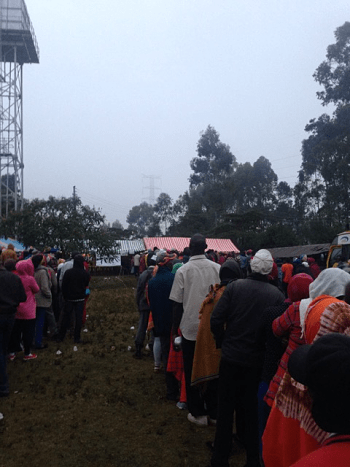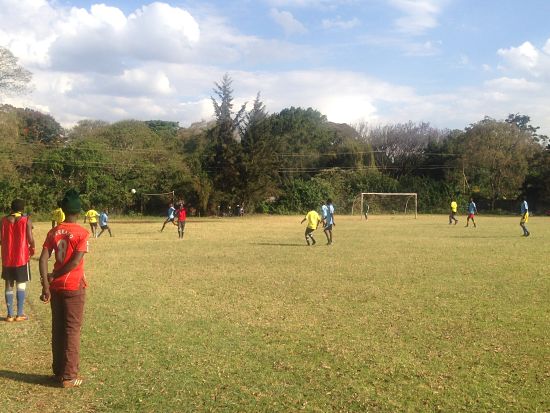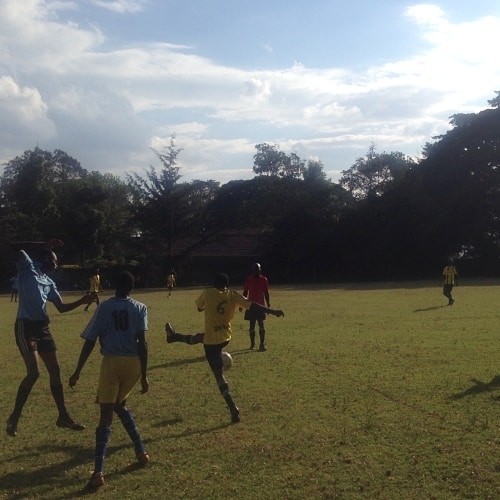Victor flew into the tackle, blocking the opponent’s shot at goal. Shouts of praise went up from the fans and substitutes standing on the touch-line. “Sawa Victor!” (“Nice Victor!”). “Asanta Victor!” (“Thank you Victor!”). “Huyu mluhya huyo!” (“This one’s a Luhya that one!”). The last phrase caught my attention. Spoken emphatically by his team-mate John Kamau – a 19-year-old striker who likes to compare himself to his footballing hero, Chelsea attacker Eden Hazard – it was both an ardent declaration of Victor’s Luhya ethnicity and his dogged contribution to the team. Victor, 21 years-old and stockily built, had been leading the line all afternoon, chasing long balls looped over the top of the opposition defence by his teammates and withstanding several poorly time tackles that had left him lying on the floor in agony on each occasion. Star Boyz, Victor’s team, were 3-1 up and on their way to a first victory in three games. His performance had been instrumental to the win. Given this context, one might better translate Kamau’s words of praise as: “He’s a special Luhya, this guy!”
For the last five months I had been training with Star Boyz, a local football team comprised of players aged between 18 and 28 from the area of southern, peri-urban Kiambu County where I continue to conduct my PhD fieldwork. Originally a plan to let off some steam alongside a busy timetable of language-learning, training and hanging out with the players of Star Boyz had begun to provide me with new perspectives on masculine sociality and friendship – themes related to my long-standing research interest in the predicament of young men in an era of mass unemployment and underemployment in Africa and beyond. Practically all the Star Boyz players hail from low-income households aspiring to middle-class status. After leaving high school many had begun to lead what is colloquially referred to as a “hustling” life-style in the peri-urban wage economy. My friend and neighbour James, a 21-year-old Gikuyu and Star Boyz midfielder, frequently takes temporary manual work (kibarua) on local construction sites paying 500 Kenyan shillings per day (approximately 5 USD). For James, this fairly gruelling work simply provides “money so you’re not broke” since he regularly goes for long periods without being called by his boss, though he tries to save what he can towards building materials for a house he plans to build on his family’s plot of land.

But since Kenya’s August 2017 elections, I had begun to take a growing interest in the significant role of three Luhya players, of which Victor was one, in the predominantly Gikuyu team and broader social setting. In the early months of fieldwork I had come to understand that whilst my fieldsite is largely comprised of Gikuyu-speakers who identify themselves in ethnic terms as Gikuyu, it is also home to a small proportion of Luhya, Luo and Kisii wage migrants who have moved closer to Nairobi to search for cash wages (“kutafuta pesa”).
The lives of these migrants and their families seemed significant given that Kenyan politics is often viewed through the prism of ethnic division: a competition between “tribal” blocs mobilised by a cadre of elite politicians manoeuvring for the ultimate prize of the Presidency (Mueller 2008). With that in mind, the governing Jubilee Party can be seen as an alliance of Gikuyu and Kalenjin ethnic constituencies represented by President Uhuru Kenyatta and Deputy-President William Ruto respectively. Uhuru is the political inheritor to the Gikuyu, Embu and Meru (GEMA) hegemony created by Kenya’s first President Jomo Kenyatta (and not coincidentally President Uhuru’s father). The original Kenyatta is famously rumoured to have used oaths to bind together these groups from the region of central Kenya (of which Kiambu is a part) with the aim of maintaining a grip on the Presidency and the access to resources the position continues to provide (Branch 2011: 85). A sense of entitlement amongst Gikuyu has been fostered by their elites who promulgate the notion that independence was won by specifically Gikuyu Mau Mau fighters, whatever the truth of such claims may be (see Lonsdale 1992). Meanwhile, Luo and Luhya communities that comprise the bulk of support for the National Super Alliance (NASA) – a conglomeration of opposition parties – have found their western homelands historically marginalised by government development schemes that have favoured “Kikuyuland”.
A month earlier in September, however, the usual story of GEMA-Kalenjin political dominance took a twist as the results of the August Presidential election that had returned incumbent Uhuru Kenyatta were annulled by the Supreme Court and a re-run was announced. As a result, everyday life in Kiambu had effectively returned to a state of waiting. My interlocutors from low-income families complained to me that as a result of this liminal period money had become scarce (“pesa imekosa”). Business ground to a halt, with traders avoiding Nairobi due to fears of being caught up in protests triggered by the opposition and counter-protests by Jubilee Party supporters. Gikuyu vernacular radio reports used the word “nduma”, meaning darkness but with connotations of confusion, to evoke the state of uncertainty that broadcasters suggested many Gikuyu felt after “ũthamaki witũ” (“our kingship”, that is to say, vernacular radio references to the president as “mũthamaki” imply the monarchical rule of a king) had apparently been snatched from them by the aici (thieves) of the Supreme Court. Local opinion of opposition leader Raila Odinga was at an all time low, and he was frequently referred to as a self-interested “mjinga” (fool) in conversations. If NASA was a dirty word before the election, it was even more so after September. In response to the fresh elections announced by the Supreme Court, NASA organised a series of protests in Kenyan cities, arguing that the Independent Electoral and Boundaries Commission (IEBC) could not be trusted to oversee fresh elections (which NASA claim were rigged first time around in favour of the Jubilee government). Hate speech on social media escalated, and on Kiambu County Facebook groups Jubilee supporters posted their praise for police violence meted out to Luo NASA followers protesting in western Kenya. NASA supporters hit back, accusing Gikuyu of being gullible “warus” (potatoes, a staple in central Kenya), mindlessly following their leaders with no thought for the countless allegations of corruption on Jubilee’s watch.
Given this broader context of inter-ethnic tension, Kamau’s praise for Victor that made merit of his being Luhya seemed particularly striking. A football match might seem like an odd place to reflect on Kenya’s recent political turbulence, but given the primacy many scholarly and media commentators have given to ethnic division both before and after the election, it is sometimes useful to step down from the macro-level of such analyses and into the everyday lives of those living out these events.
A dangerous slippage occurs when everyday life begins to be viewed with categories gleaned from the study of ethnic multi-party politics.
The style of sociality amongst Star Boyz players offers an alternative perspective on Kenyan society at a crucial moment. Victor’s apparent embodiment of a stereotypical Luhya trait that day, physical strength (nguvu), hinted at the objectification and praise of difference – alternative political possibilities for a Kenyan public culture that often seems to fetishise a vague notion of “unity” (umoja) at the expense of fostering relations across ethnic differences. Kamau’s words of praise were a far cry from the “One Kenya, One Tribe” campaign run by NGOs and civil-society organisations to foster a sense of Kenyanness by downplaying ethnic identities. “You shouldn’t align to your tribe, but to your country”, goes its logic, one that seems to recognise both the precarity of national unity and the deep significance of aspects of “tribe” for many Kenyans from childhood, such as language. On the other hand, middle-class civil society frequently observes that young men in Nairobi’s informal settlements transcend their ethnic identification through their common identification with the more immediate, pressing reality of urban poverty. Yet the predominantly Gikuyu character of Kiambu County precludes this interpretation too. Praise for difference reminds us that Kenyan nationalism need not be premised on the “fraternity” of Kenyanness alone but might be achieved through relations akin to “cousinage” that both recognise ethnic difference yet claim affinity (Ben-Yehoyada 2014). Such relations may crop up even in unlikely places like youth football teams. Rather than a commensurating unity, Kenyan nation-building may be better served by an appreciation of these local instances that make difference the basis of friendship and cooperation.

Not long after half-time Wamalwa, another of Star Boyz’ three Luhya players, was substituted after a long shift patrolling the midfield. Like Victor, Wamalwa’s tireless running and tackling had been critical to the victory. Wamalwa, as I found out through pitch-side conversations whilst watching the game that day, had been nicknamed Wetangula by his team-mates. Nick-naming is fairly common amongst the group, but whilst other team members are named after famous footballers like Eliaquim Mangala or N’Golo Kante, Wamalwa has been named after his ethnic compatriot Moses Wetangula, the Luhya leader of the FORD-Kenya political party and senator of Bungoma County. Wetangula, it should be noted, is a somewhat archetypal Kenyan politician having managed to mobilise supporters from his own ethnic background. He is, in a sense, one of the most famous Luhya in Kenya.
As Wamalwa walked off the pitch and came towards us, a broad smile on his face knowing the team were on the verge of victory, Kamau grabbed his friend by the shoulders, roughing his hand over his shaved head whilst chanting “NASA! NASA! NASA!”. I was struck by the juxtaposition of Kamau’s playful affection whilst simultaneously elaborating Wamalwa’s difference, not necessarily in his eyes, but according to the macro-scale parameters of ethnic multi-party politics. Kamau was joking that Wamalwa, as a Luhya, was inherently a NASA follower (mfuasi wa NASA or mtu wa NASA). Wamalwa himself was smiling, having become used to being teased by Kamau for apparently being an ethnic opponent and outsider. Of course, having played in the same team for over a year, Kamau knows full well that Wamalwa won’t take this personally. After all, Wamalwa grew up in the same area as Kamau and speaks the Gikuyu language fluently whilst Kamau’s brash character has given him a degree of leeway to tease his team-mates in this fashion.
The Godfather of structural-functionalist anthropology, A.R. Radcliffe-Brown (1940: 197-8) once wrote that such “playful antagonism” expresses the possibility of divergent interests and potential conflict by turning it into the very stuff of social relations. By placing the possibility of Wamalwa supporting NASA in the open, whether in fact he did or did not, Kamau signalled his indifference to the purchase such categories might actually have on their friendship. The categories of “NASA” and “Jubilee” themselves seemed laughable – as if they could ever aspire to fully account for a person’s identity (see also Yeh 2017). Far from being a pressing issue, national or Presidential politics are rarely discussed seriously by Star Boyz players, being somewhat distant to their hustling lives on local construction sites and tea farms.
The parroting of political slogans signals their banality at the level of everyday life for peri-urban Gikuyu youths like the Star Boyz players who are concerned with maintaining more immediate social relations than the divisions Kenyan politics often presents as paramount.
The seriousness of such politics is turned into the butt of the joke: What could Kamau possibly have against Star Boyz’s best striker or most hard-working midfielder, men who had become his friends in the midst of the long season? The logic of tribal division seemed absurd, even funny in the face of real knowledge of the ostensible other.
***
In Kenya’s era of multi-party politics, the experience of ethnicity as the primary vector of political mobilisation structures understandings of self and other. Politicians’ appeals to ethnicity would be ineffective if this were not the case. But neither is knowledge of the other exhausted by ethnic categories imported from the realm of politics. The experience of peri-urban living and labour migration affords Gikuyu alternative ways of knowing ethnic others that allow understandings of difference gleaned from politics to be turned on their head. When a person’s virtues are gauged in proximity, the very notion of ethnic division itself can be objectified as worthy of ridicule, its way of looking at the world rendered useless from the perspective of friendship. Whilst tales of hate speech and hate speech itself circulate on social media, indicating a widening gap between Gikuyu and ethnic communities aligned with NASA during the election period, ethnography can provide alternative narratives to tell of Kenya’s year of two elections. It can remind us of the possibilities for solidarity and alignment that exist within contexts already made knowable as ones defined by ethnic chauvinism.
Notes
This essay draws on my current PhD field research, supported by the UK Economic and Social Research Council (ESRC). All names and some biographical details have been anonymised.
References
Ben-Yehoyada, Naor. 2014. ‘Transnational Political Cosmology: A Central Mediterranean Example’. Comparative Studies in Society and History 56 (4): 870-901.
Branch, Daniel. 2011. Kenya: Between Hope and Despair, 1963-2011. London: Yale University Press.
Lonsdale, John. 1992. ‘The Moral Economy of Mau Mau: Wealth, Poverty & Civic Virtue in Kikuyu Political Thought’ in Unhappy Valley: Conflict in Kenya & Africa, Book Two: Violence and Ethnicity (eds. B. Berman & J. Lonsdale). London: James Currey.
Mueller, Susan D. 2008. ‘The Political Economy of Kenya’s Crisis’. Journal of Eastern African Studies 2 (2): 185-210.
Radcliffe-Brown, A.R. 1940. ‘On Joking Relationships’. Africa: Journal of the International African Institute 13 (3): 195-210.
Yeh, Rihan. 2017. ‘Visas, Jokes, and Contraband: Citizenship and Sovereignty at the Mexico–U.S. Border’. Comparative Studies in Society and History 59 (1): 154–182.





Nice fieldnotes. I suggest that Peter follows up on his insight that football can tell us much about politics and vice versa. Some work has been done along this line on Africa (and beyond), a good starting point is surely the ethnography of Bea Vidacs. 2010. Visions of a Better World: Football in the Cameroonian Social Imagination. LIT. and her essays on the subject.